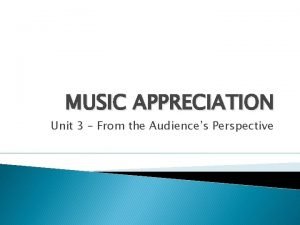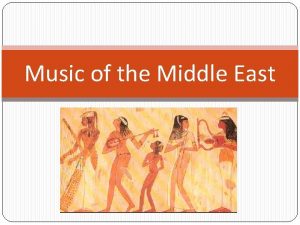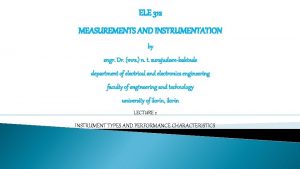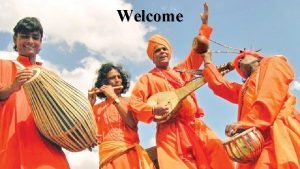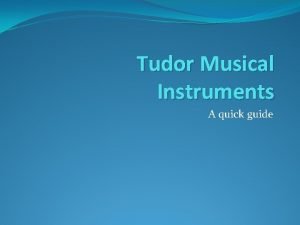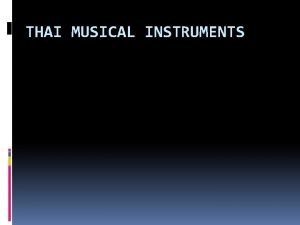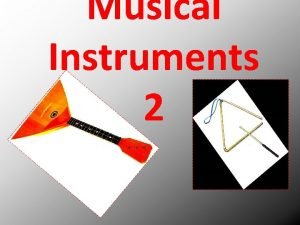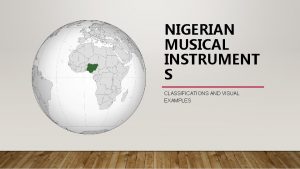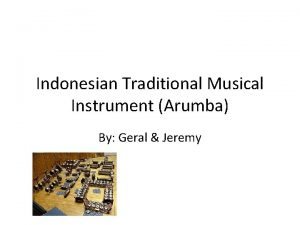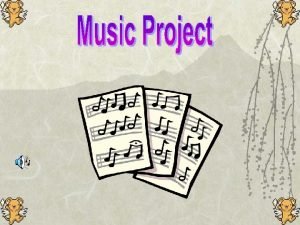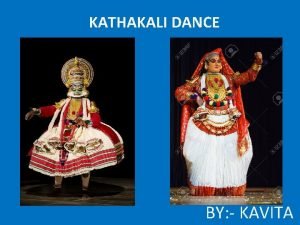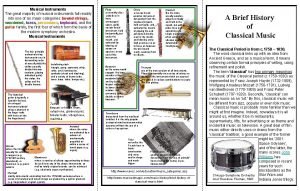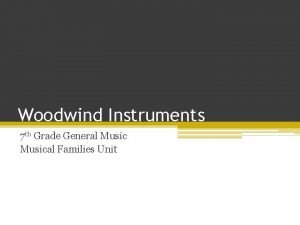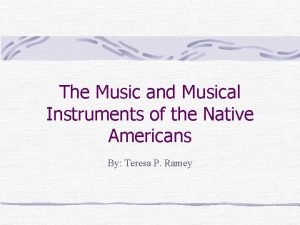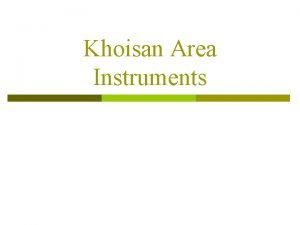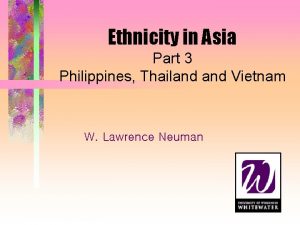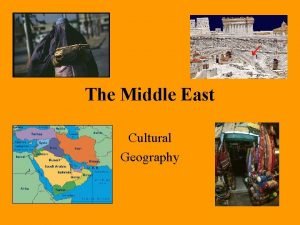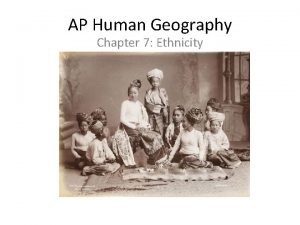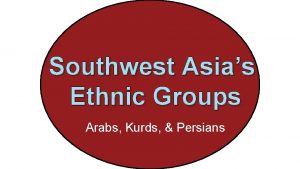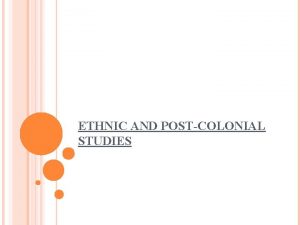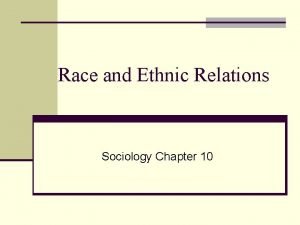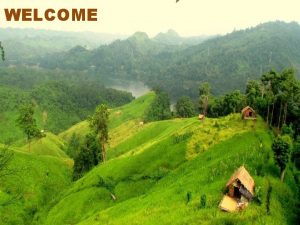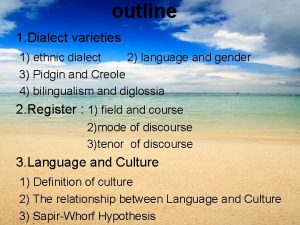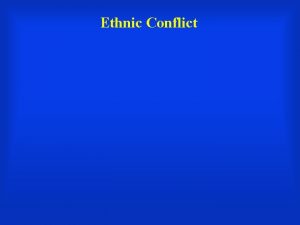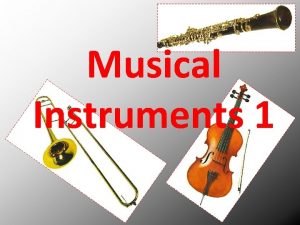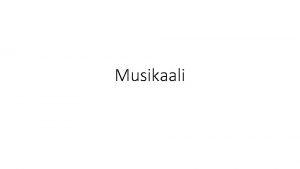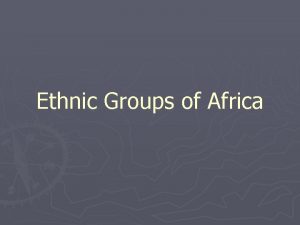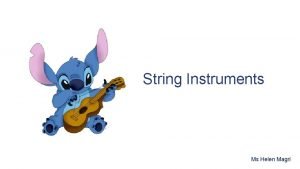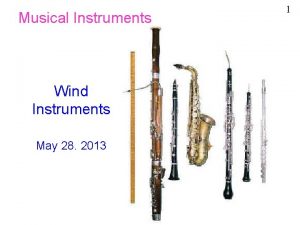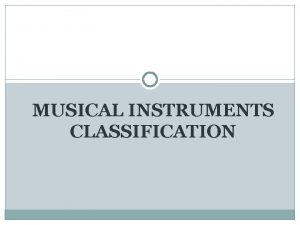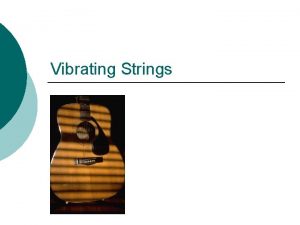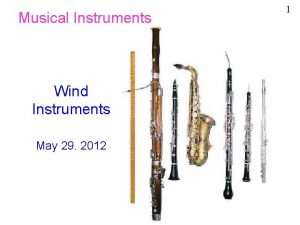Philippine Ethnic Musical Instruments Aerophone is any musical

















































- Slides: 49

Philippine Ethnic Musical Instruments

Aerophone • is any musical instrument which produces sound primarily by – causing a body of air to vibrate – without the use of strings or membranes – and without the vibration of the instrument itself adding considerably to the sound.

Bansiq anunoo Ethnic group: H ro Location: Mindo rophone, e A : n o ti a ic if s s Cla ute: chip-on-ledge fl Description Slightly curved bamboo tube, closed on one sid e by a node and cut off under an angle. On the cu t off surface an ex tra piece of banboo is tied. Dimensions: len gth: 31, 5 cm. , diameter: 1, 5 cm.

Kalleleng Nose flutes Description bes, Long bamboo tu d by the closed at one en e node in which th burnt. The is le o h g in w lo b nger flute has three fi ing hole is holes. The blow angle placed under an and the against the nose ws into lo b y tl n e g r e y la p the tube. m top to Dimensions (fro bottom): The end of the tubes with the blowing hole burnt in the node. 71 cm. , - flute 1: length: On the right: the Tongali from the Kalingga diameter: 2 cm. 1, 5 cm. , 5 : th g n le : 2 te u - fl Ethnic group: Bontoc diameter: 2 cm. Location: North Luzon (Cordillera) Classification: Aerophone, vertical flute, nose flute

The kalleleng is held against the nostril; the other nostril is plugged

Lantuy Ethnic group: Hanunoo Location: Mindoro Classification Aerophone, horizontal flute Description Bamboo tube, closed at one end by a node (on the right on the picture). Dimensions; length: 31, 5 cm. , diameter: 1, 5 cm.

Palandag Ethnic group: Bagobo Location: SE Mindanao Classification Aerophone, lip valley flute (notch flute) Description Two by two fin gerholes. Protru ding mouthpiece wit h a hole. The in strument is decorated with carvings blacke ned by burning. For pla ying technique: see Pulalu Dimensions: len gth: 18, 6 cm, dia meter 1, 2 cm.

C te u l f g n i t r ou Local name : unknown Group: Bontoc Location: North Luzon (Cordillera) Classification: Aerophone, vertical flute Description Short bamboo tube, cut off on the node and closed with a piece of wood, lower part of the hole half covered, with a burnt in hole. Dimensions: length: 14, 7 cm. , dimater: 1, 6 cm.

Paldong Ethnic group: Kalingga Location: North Luzon (Cordillera) Classification Aerophone, lip valley flute (notch flute) Front view Description cut at Open bamboo pipe, top end e by an angle (see pictures). Thre one fingerholes. For playing technique: see Pulalu , Dimensions: length: 69, 2 cm diameter 1, 6 cm. The mouthpiece, the on the left is the Paldong

Pulalu Ethnic group: Mansaka Location: SE Mindanao Classification Lip valley flute (notch flute), aerophone Description Open bamboo pipe, top end cut at an angle (see pictures). Two by two fingerholes. Dimensions: length: 48, 7 cm, diameter 1, 4 cm The mouthpiece, the on the right is the Pulalu

Tongali Ethnic group: Kalingga Location: North Luzon (Cordillera) Classification Aerophone, vertital flute. nose flute Description Long bamboo tubes, the closed at one end by node in which the t. blowing hole is burn The flute has three finger holes. The ed blowing hole is plac st under an angle again yer the nose and the pla e gently blows into th tube. : 57, 5 Dimensions: length cm. , diameter 2 cm. It is held against the nostril; the other nostril is plugged The end of the tubes with the blowing hole burnt in the node. In the middle and on the left are Kalleleng from the Bontoc.

Sahunay Ethnic group: Taosug Location: Sulu archipelago (muslim south) Classification Pipe with reed (clarinet): aerophone Description Tube with six fingerhole s; mouth piece of bamboo with cut out reed; mouth shie ld made of coconut shell; bell made of leaf (probably bamboo) and blue plasti c ribbon. Dimensions: Total length: 28, 4 cm. di am. tube with fingerholes: 0, 65 cm. widest diam bell: 3, 7 cm

Sahunay The piece of bamboo with the cut out reed was lost during storage in the depots of the museum. The reed's blade is on the lower side.

Chordophone • A chordophone is any musical instrument • which makes sound by way of a vibrating string • or strings stretched between two points

Kudlung Ethnic group: Bagobo Location: SE Mindanao Classification Chordophone, two stringed boat lute Description e of wood, d a m te lu d e g in Two str , one for y d lo e m e th r fo one string are glued ts e fr t h ig E. e n the dro The body. te lu e th f o k c e on the n carved with is t n e m u tr s in e of th e neck and h T. s rn e tt a p ic tr geome ed with horse rn o d a re a d a e h e th (originally o tw s a h il ta e th hair; skin; the o a b ra a c f o s e c ie three) p work. d a e b h it w d e rn o strap is ad th: 98 cm. , Dimensions: leng eight: 5, 5 cm. h. , m c , 5 8 : th id w The head, adorned with horse hair

Kudlung Ethnic group: Bagobo Location: SE Mindanao Classification Chordophone, two stringed boat lute Description e of wood, d a m te lu d e g in Two str , one for y d lo e m e th r fo one string are glued ts e fr t h ig E. e n the dro The body. te lu e th f o k c e on the n carved with is t n e m u tr s in e of th e neck and h T. s rn e tt a p ic tr geome ed with horse rn o d a re a d a e h e th (originally o tw s a h il ta e th hair; skin; the o a b ra a c f o s e c ie three) p work. d a e b h it w d e rn o strap is ad th: 98 cm. , Dimensions: leng eight: 5, 5 cm. h. , m c , 5 8 : th id w The body, carved with geometric patterns, the glued on frets and the strap The tail with the two (originally three) piece sof carabao skin

side view Kudlung Ethnic group: B'laan ao Location: SE Mindan art) (christian / animist p Classification ringed Chordophone, two st boat lute Kudlung, top view Kudlung, the head with the handle for fine tuning

Kudlung Description Two stringed lute mad e of wood, one string for the melody, one for the d rone. Eight frets originally held in placed on the n eck of the lute by a sticky ru bbery substance, called sico co. The lute has a mechanism for fine tuning consisting of a wooden comb tied ag ainst the outer part of the lute 's neck and the melody strin g. Dimensions: length: 118 cm. , width: 20 cm. , heigh t: 10, 5 cm. The tail The lower part of the body, with the plectre (akbit) stuck into a hole

Kudyapi Sideview The head, decorated with floral motives, 'okiran' The tail, decorated with the 'crocodile' motive

Ethnic group: Marano Location: West Central Mindanao (muslim south) Classification Chordophone, two stringed boat lute Kudyapi Description of wood, one e ad m te lu ed g n ri st o Tw r the drone. fo e n o , y d o el m e th r string fo ce placed la p in d el h ly al in g ri o Eight frets by a sticky on the neck of the lute decorated is te lu e h T. ce an st b su rubbery tail is carved to e th ; es v ti o m l ra o fl h wit codile head. represent a stylised cro idth: 11, 5 w. , cm 2 5 1 : th g n le s: Dimension cm. The bridge, made of wood and carabao horn

Serongagandi aw Ethnic group: Maran est Location: Central-w south) Mindanao (muslim Classification e Cither: chordophon Top view Back view The bridge is placed over a hole Description Decorated bamb oo tube, closed by a nod e at both ends. Two strin gs cut free and lifted by ba mboo sticks and connected b y a wooden bridge (or 'platf orm'). The bridge is situate d over a hole which makes th e tube a resonator. Length: 41 cm. diameter: 9 cm.

Ethnic group: T'boli Location: South east Mindanao Classification Bamboo cither: chordophone, idiochord Sludoy Description amboo; Tube cither made of b e tube; five strings cut from th ith one the tube is cut open w eld full length crack and h rips at together by bamboo st the both ends. In this way ing tube forms the resonat t. body of the instrumen ed leaf Usually a piece of dri d of the is placed in the top en tion is tube of which the fucn not clear. 0 cm. , Dimensions: length: 8 diameter 11, 5 cm. The sludoy, turned 90 degrees for each picture

A T'boli woman plays the sludoy, the woman in the background plays a hegelung.

Kolitong Ethnic group: Kalingga Location: North Luzon, Cordillera Classification Chordophone, idiochord tube zither The strings are cut loose from the skin and lifted by wooden bridges The star shaped opening in the node Description Bamboo tube, closed at both end by a node. In both nodes a star shaped opening is cut. Five strings are cut loose from the skin, and lifted and tuned with small pieces of wood. The tube is cracked and slightly opened to improve resonance. Dimensions: length: 80 cm. diameter: 11, 5 cm.

Idiophone • An idiophone is any musical instrument • which creates sound primarily – by way of the instrument's vibrating, – without the use of strings or membranes • Most percussion instruments which are not drums are idiophones.

Afiw Description instrument e th ; ss ra b f o e d a M with the is held horizontally nt of the metal tongue in fro ft end is le e h T. th u o m d e n ope mb of the either hit by the thu ed (see right hand or pluck This photograph below). gue vibrate makes the metal ton nd. The which causes a sou sonator mouth serves as a re e shape and th g in g n a h c y b d n a ing, the n e p o th u o m e th f o size anged, thus overtones can be ch y strongly B. y d lo e m a g n ti a cre the volume breathing in or out ell. can be changed as w of wool. The string is made : 11, 5 cm. , Dimensions: length width: 1, 3 cm. Group: Bontoc Classification Idiophone, jaw harp Ethnic group: Bontoc Location: North Luzon (Cordillera) The Afiw is held before the opened mouth

Kinaban Ethnic group: Hanunoo Location: Mindoro Classification: Idiophone, jaw harp Description Made of bamboo; the instrument is held horizontally with the bamboo tongue in front of the opened mouth. The left end is hit by the thumb of the right hand. This makes the bamboo tongue vibrate which causes a sound. The mouth serves as a resonator and by changing the shape and size of the mouth opening, the overtones can be changed, thus creating a melody. By strongly breathing in or out the volume can be changed as well. For a picture of the instrument in use: see the Kubing from the Atta. Dimensions: length: 14, 9 cm. , width: 0, 8 cm.

Kubing Ethnic group: Atta Location: SE Mindanao Classification: Idiophone, jaw harp Description Made of bamboo; the instrument is held horizontally with the bamboo tongue in front of the opened mouth. The left end is hit by the thumb of the right hand. This makes the bamboo tongue vibrate which causes a sound. The mouth serves as a resonator and by changing the shape and size of the mouth opening, the overtones can be changed, thus creating a melody. By strongly breathing in or out the volume can be changed as well. Dimensions: length: 20, 8 cm. , width: 1 cm. Quintik Ofong plays the kubing (T'boli)

Kubing Description Made of bamboo; the instrument is held horizontally with the bamboo tongue in front of the opened mouth. The left end is hit by the thumb of the right hand. This makes the bamboo tongue vibrate which causes a sound. The mouth serves as a resonator and by changing the shape and size of the mouth opening, the overtones can be changed, thus creating a melody. By strongly breathing in or out the volume can be changed as well. For a picture of the instrument in use: see the Kubingfrom the Atta. A thin piece of bamboo of appr. 2 cm. length on the left side, for hitting and causing the tongue to vibrate, is broken off. Dimensions: length: 23, 6 cm. (or. appr. 26 cm. ). , width (widest): 2, 4 cm, (smallest) 1, 2 cm. Ethnic group: Maranao Location: West Central Mindanao (muslim south) Classification Idiophone, jaw harp;

Kumbing Ethnic group: Manobo Location: Central Mindanao Classification: Idiophone, jaw harp Description Made of bamboo; the in strument is held before the opened mouth with the cut out tongue in front of the m outh opening. The left end is hit by th e right hand. This makes the metal tongue vibrate which ca uses a sound. The mou th serves as a resonator and by changi ng the shape and size of the mouth opening, the overtones can be changed, thus cr eating a melody. By strongly breathing in or out the volume can be changed as well. Dimensions: length: 14 , 9 cm. , width: 0, 9 cm.

Balingbing Group: Kalingga Location: North Luzon (Cordillera) Classification Idiophone, bamboo buzzer and a s e u g n Description to o w T. d e side close ent is played Bamboo tube, on m u tr s in e h T. le ode; ho crack up to the n st the arm or in a g a s e u g n to e f th opening d n a by beating one o g in s lo c y b be changed n a c d n u o s t; s ri w ast seven le t a y b d e y la p lay their p r e the hole. Usually y la P r. e z z u with one b individuals, each s fit together rn e tt a p ll a , rn e tt s while w ro own rythmic pa g n lo rm fo n layers ca meadow). l a tr n ('interlocking'). P e c a s a h c en space (su dancing in an op epending on d. m c 0 5 to 0 3 from Dimensions: vary ht. desired tonal heig

Palipal Ethnic group: Ifugao Location: North Luzon (Cordillera) Classification Idiophone, bamboo clapper Side view Top view Description Bamboo tube, one end open; cut open in the middle; upper part cut into two halves. The instrument is played by shaking: one half swings up and down and in the down swing hits the lower half. For playing technique: see Balingbing

Tagutok Ethnic group: Maranaw Location: Central-west Mindanao (muslim south) Classification Idiophone Description Decorated bamboo scraper, length: 46 cm. , diameter: 9 cm.

Bangibang Group: Ifugao Location: North Luzon (Cordillera) Classification Idiophone, percussion bar Description Set of at least seven wooden bars made of hard wood. Each bar has its own pitch and is hit by the player with a short stick of hard wood. Players have one stick each and play their own rythmic pattern, which fall together ('interlocking'). See also: Balingbing. Dimensions: length: 47, 5 cm. , height: 5 cm. , diameter: 2, 6 cm.

Gabbang Front view Top view The two beaters Ethnic group: Taosug Location: Jolo (muslim south) Classification Idiophone, xylophone Description Xylophone with 17 keys made of bamboo, separated by metal nails. The resonating case is dcorated with floral motives. At the sides are two mirrors. The beaters are made of wood with a piece of tube rubber Dimensions: length: 102 cm. , width: 51 cm. height: 37 cm.

The Gabbang can be played as a solo instrument. Sometimes a duo is formed with a 'biula', a local violin. The resonating case, decorated with floral motives A Taosug woman plays the gabbang.

Kulintang (small) Front view Top view The left side of the instrument with the largest iron plate Ethnic group: Maranao Location: Central-west Mindanao (muslim south) Classification Idiophone, metal xylophone Description A set of eight iro n plates with boss on a w ooden frame. The plates are tuned and played as a k ulintang. The set is consid ered to be a practice set for children, although adults a lso play the instrument. Dimensions: leng th: 95 cm. , width: 14 cm. height: 9 cm.

Kulintang ensemble Ethnic group: Maranao Location: Central-west Mindanao (muslim south) Classification Idiophones: gong chime and large gong Membranophones: conical drum and cylindrical drum Local names Set of eight gongs: Kulintang Large gong: Agung Cylindrical drum: Gandang Conical drum: Dadabuan The complete ensemble

Description Set of eight gongs made of bronze, on a wooden stand in the shape of a Sarimanok(mythical bird, divine messenger). Accompanied by one larger gong (here made of iron, but usually also made of bronze) and two drums. The eight small gongs differ in pitch but the height of the tone is not fixed and can differ per set. The number of large gongs can vary from one to several gongs of different pitch and size. The small gongs are struck with two sticks of appr. 30 cm. length and made of a soft kind of wood, probably of the papaya tree. The large gong is struck with a special beater. The conical drum is struck with a thin piece of bamboo of appr. 40 c. m. length. The cylindrical drum is struck with either the hands or two short wooden sticks. To indicate the dimensions of the whole set, the length of the Sarimanok-shaped stand is 2, 60 mtr, from head to tail. For other dimensions, see the pages of the other instruments of the ensemble (see above). Kulintang ensemble The head representing the mythical bird Sarimanok

Two gongs on the stand Kulintang ensemble Remarks The drums, the stand the frame are all quite roughly made but elaborately decora ted with colourfully painted woo d carvings, called 'okiran'. The stand for the large gong is a copy based on photograph s of a stand used by a Maranaw cultural group. The stand was made for the exhibiton 'Ugnayan, music in the Philippines', in 1977 in the Th e Hague Municipal Museum an d in 1978 in the Rotterdam Ethnographic Museum.

Agung Group: Maranao Classification Idiophone, bossed gong Location: West Central Mindanao (muslim south) Front view Description Gong with boss, made of iron. The gong is part of the Kulintang ensemble Dimensions: diameter: 45 cm. depth: 21 cm. Side view

Tanggu Ethnic groups: Kalagan, B'laan, Manuvu, Bagobo, a. o. Location: South east Mindanao Classification Gong chime: idiophones Local names Set of eight gongs: Tanggu Largest gong: Unsaranan (lit. mother) The other gongs (rising in pitch): Bandilanan, Tubaganan, Litokanan The highest gong: Tulus The ostinato: Patawaganan Beater: Tinkulai

Tanggu Description Set of eight small gongs made of iron, usually han ging on a rest of rope. The lower right gong is played as an ostinato while the m elody is played on th e other gongs, arou nd the ostinato.

The large Tanggu, (Kaloagan, Mount Tandawanan, SE Mindanao)

Tongkaling Ethnic group: B'laan Location: SE Mindanao Classification Idiophones, pellet bells or crotal bells Local names Tongkaling: larger brass pellet bells Gurung-gurung: smaller brass pellet bells Tongkaling, bronze bells, on a dance girdle Description Brass bells, used as an amulet or as a musical instrument. In the picture fourteen brass bells is fixed to a metal girdle. Nine of these bells have a particular design (a tiger's face). The girdle is used during a particular dance. For an extensive explanation of this particular type of bells and its use, see the pages on tiger bells. A Tongkaling with a particular design

Membranophone • • A membranophone is any musical instrument which produces sound primarily by way of a vibrating stretched membrane. Most membranophones are drums

Dadabuan Ethnic group: Maranao Location: West central Mindanao (muslim south) Classification Membranophone, hour glass shaped drum Description Hour glass shaped drum made of wood; the membrane is made of carabao skin. Decorated with carvings and painted. The drum is part of the Kulintang ensemble. Dimensions: height: 59 cm. diameter (membrane): 19 cm.

Gandang Ethnic group: Ma ranao Location: West ce ntral Mindabao (muslim south) Classification Membranophone , double headed cylindrical drum Description e Cylindrical drum, mad of wood with a membrane made of carabo skin on each side. Decorated with 'okiran' motives and painted. The drum is part of the Kulintang ensemble. 4 Dimensions: height: 3 cm. , diameter: 17 cm.

Prepared by: JC de Egurrola Source: Kipas Gallery: Home of traditional art and music Url: http: //www. kipas. nl/
 Classification of gabbang
Classification of gabbang What is the hornbostel-sachs classification of tabla
What is the hornbostel-sachs classification of tabla Aerophone examples
Aerophone examples Classification of aerophone
Classification of aerophone Middle eastern double reed instrument
Middle eastern double reed instrument Null type instruments
Null type instruments Pressure measuring devices
Pressure measuring devices Chapter 12 style and function of music in society
Chapter 12 style and function of music in society Who usually likes our folk songs
Who usually likes our folk songs Tudor instruments
Tudor instruments Thailand instruments
Thailand instruments Ilocano musical instruments
Ilocano musical instruments Nigerian musical instruments
Nigerian musical instruments Indonesian traditional music instrument
Indonesian traditional music instrument Characteristics of romantic period
Characteristics of romantic period Instruments mbti
Instruments mbti Four families of the orchestra
Four families of the orchestra It is the smallest but the highest pitch
It is the smallest but the highest pitch Totayam
Totayam Old songs
Old songs Examples of brasswind instruments
Examples of brasswind instruments Ilocano musical instruments
Ilocano musical instruments Vocal music of israel almost entirely vocal
Vocal music of israel almost entirely vocal What music that employs electronic music?
What music that employs electronic music? Musical families instruments
Musical families instruments Old greek musical instrument
Old greek musical instrument Native american musical instruments
Native american musical instruments Instrument of peking opera
Instrument of peking opera Khoisan musical instruments
Khoisan musical instruments Any to any connectivity
Any to any connectivity Seknder
Seknder There aren't any carrots
There aren't any carrots Vietnam ethnic map
Vietnam ethnic map Ethnic formation
Ethnic formation Ethnic groups in the middle east
Ethnic groups in the middle east World's largest ethnic religion
World's largest ethnic religion India ethnicities
India ethnicities Southwest asia ethnic groups
Southwest asia ethnic groups Brain wrinkles southwest asia
Brain wrinkles southwest asia Ethnicity in postcolonialism
Ethnicity in postcolonialism Lesson 4 our ethnic friends (2)
Lesson 4 our ethnic friends (2) Denomination ap human geography
Denomination ap human geography Chapter 10 racial and ethnic relations review worksheet
Chapter 10 racial and ethnic relations review worksheet Hajangs
Hajangs Divine masculine and feminine
Divine masculine and feminine Whats ethnic group
Whats ethnic group An anthropologist looks at ballet summary
An anthropologist looks at ballet summary Latino americans
Latino americans Whats an ethnic religion
Whats an ethnic religion Nigga
Nigga


